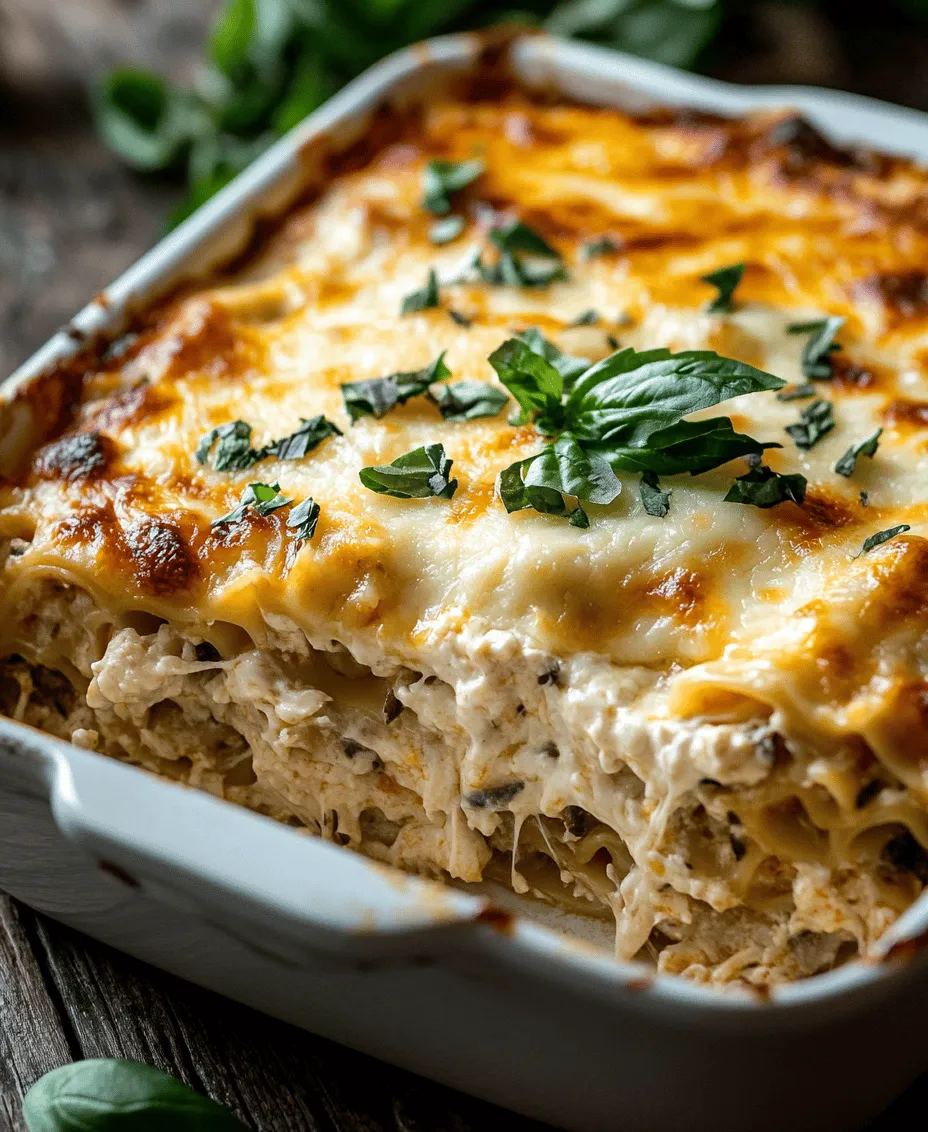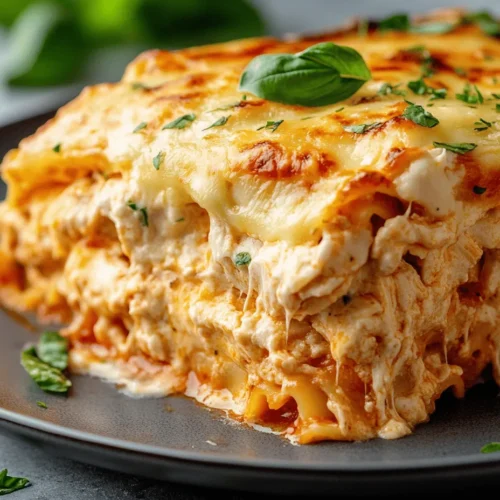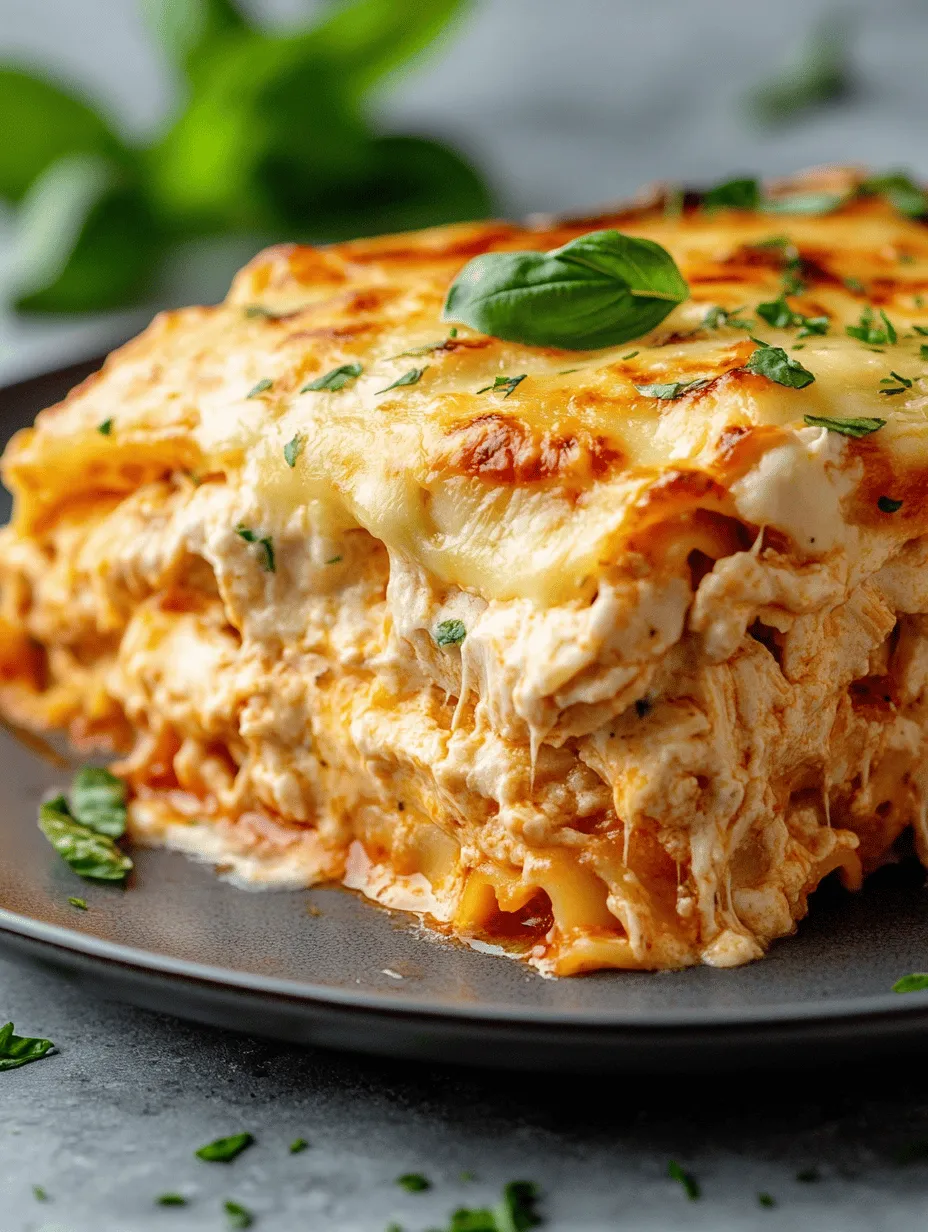Lasagna has long held a special place in the hearts and homes of many, often considered the ultimate comfort food. Its rich, layered structure and warm, hearty flavors evoke a sense of nostalgia and satisfaction. From family gatherings to cozy weeknight dinners, lasagna is a dish that brings people together. While the traditional meat-based version is beloved, we are diving into a delightful twist that promises to elevate your lasagna game: Creamy Chicken Lasagna with White Sauce. This recipe combines tender chicken, a luscious béchamel sauce, and a medley of cheeses, resulting in a dish that is both comforting and indulgent.
In this recipe, we also incorporate nutritious ingredients like spinach, which not only adds a vibrant color but also packs a healthy punch. Spinach is loaded with vitamins and minerals, making it an excellent addition to this creamy delight. Chicken, another star ingredient, is a lean source of protein that contributes to the overall health benefits of this dish. With the combination of these wholesome ingredients, you can enjoy a delicious meal that doesn’t compromise on nutrition.
So, if you’re ready to embark on a culinary adventure that will impress your family and friends, join us in exploring the detailed steps to create this mouthwatering Creamy Chicken Lasagna with White Sauce.
Understanding the Components of Creamy Chicken Lasagna
Before we dive into the cooking process, it’s essential to understand the various components that make up this dish. Each ingredient plays a crucial role in achieving the perfect balance of flavors and textures.
Lasagna Noodles: Types and Cooking Methods
Lasagna noodles are the backbone of this dish, providing structure and support for the layers of goodness that make up lasagna. There are primarily two types of lasagna noodles: traditional and no-boil. Traditional lasagna noodles require boiling before assembly, whereas no-boil noodles can be layered directly into the dish without prior cooking.
For this recipe, we recommend using traditional noodles for their ability to absorb flavors and maintain a satisfying texture. When preparing traditional lasagna noodles, it’s essential to cook them al dente – firm to the bite – to prevent them from becoming mushy during the baking process. To cook, bring a large pot of salted water to a rolling boil, add the noodles, and follow the package instructions for cooking time. Drain and lay them flat on parchment paper to prevent sticking.
The Importance of Choosing Quality Chicken
When it comes to choosing chicken for your lasagna, quality matters. Opt for boneless, skinless chicken breasts or thighs, as they are tender and cook quickly. Organic or free-range chicken is often recommended for better flavor and nutritional benefits. Chicken is an excellent source of lean protein, essential for muscle growth and repair, making it an ideal ingredient for a hearty dish like lasagna.
To prepare the chicken for your lasagna, you can poach, grill, or sauté it until fully cooked. Once cooked, shred the chicken into bite-sized pieces to distribute evenly throughout the layers of lasagna. This ensures every bite is packed with flavor and texture.
Overview of Cheese Types Used: Ricotta, Mozzarella, and Parmesan
Cheese is an integral part of any lasagna, and for our Creamy Chicken Lasagna, we will be using a trio of delicious cheeses: ricotta, mozzarella, and Parmesan.
– Ricotta Cheese: This creamy cheese adds a rich, velvety texture to the filling. It’s often mixed with herbs and spices to enhance its flavor. Ricotta is also a great source of calcium and protein, making it a nutritional powerhouse.
– Mozzarella Cheese: Known for its meltability, mozzarella cheese creates that gooey, stretchy texture that everyone loves in lasagna. It also adds a mild flavor that complements the other ingredients beautifully.
– Parmesan Cheese: This hard cheese brings a sharp, nutty flavor to the dish. Sprinkled on top before baking, it creates a deliciously crispy crust that adds an extra layer of texture.
Together, these cheeses create a harmonious blend of flavors that make this lasagna irresistible.
Making the Béchamel Sauce
One of the stars of this Creamy Chicken Lasagna is the béchamel sauce, also known as white sauce. This creamy sauce serves as a base for the dish, adding moisture and richness to the layers.
Definition and Significance of Béchamel Sauce in Lasagna
Béchamel sauce is a classic French sauce made from a roux (butter and flour) mixed with milk. It acts as a creamy binder that holds the layers of lasagna together while providing a smooth, luscious texture. In this recipe, the béchamel sauce enhances the overall flavor profile and ensures that each bite is decadently creamy.
Step-by-Step Guide on How to Prepare Béchamel Sauce
1. Melt the Butter: In a medium saucepan, melt 4 tablespoons of unsalted butter over medium heat.
2. Add the Flour: Once the butter is melted, whisk in 4 tablespoons of all-purpose flour. Cook the mixture for about 1-2 minutes, stirring constantly. This will create a roux and should be golden in color.
3. Gradually Add Milk: Slowly pour in 4 cups of whole milk while continuously whisking to prevent lumps. It’s essential to add the milk gradually to ensure a smooth consistency.
4. Season the Sauce: Continue to cook the mixture over medium heat, whisking frequently until it thickens and reaches a creamy consistency. This should take about 5-7 minutes. Season with salt, pepper, and a pinch of nutmeg for added flavor.
5. Final Touches: Once thickened, remove the béchamel sauce from the heat and set it aside. This sauce can be made ahead of time and stored in the refrigerator, covered, until you’re ready to assemble your lasagna.
Ingredients and Their Roles in Béchamel Sauce
– Butter: Provides richness and flavor, acting as the base for the roux.
– Flour: Thickens the sauce and gives it structure.
– Milk: The primary liquid that creates the creamy texture.
– Seasoning (Salt, Pepper, Nutmeg): Enhances the overall flavor profile, making the sauce more complex.
Tips for Achieving the Right Consistency and Flavor
– Use Whole Milk: For a richer béchamel sauce, always opt for whole milk instead of low-fat alternatives.
– Whisk Constantly: This is crucial in preventing lumps and ensuring a smooth sauce.
– Adjust Seasoning: Don’t be afraid to taste and adjust the seasoning as you go. A well-seasoned béchamel will elevate the entire dish.
Preparing the Lasagna Noodles
Now that we have our béchamel sauce ready, it’s time to prepare the lasagna noodles. The way you cook the noodles can significantly affect the final texture of your lasagna.
Importance of Cooking Noodles Al Dente for Optimal Texture
Cooking the noodles al dente ensures that they maintain their structure during baking. Overcooked noodles can become mushy and affect the overall integrity of the dish. The goal is to have noodles that are firm yet tender enough to layer seamlessly with the other ingredients.
Tips for Preventing Noodles from Sticking During Preparation
To prevent lasagna noodles from sticking together:
1. Use Plenty of Water: When boiling the noodles, make sure to use a large pot with ample water. This gives the noodles room to move around and reduces the risk of sticking.
2. Stir Occasionally: Give the noodles a gentle stir a few times during cooking to ensure they don’t clump together.
3. Rinse with Cold Water: After draining the noodles, rinse them under cold water to stop the cooking process and remove excess starch that can cause sticking.
Alternative Options for Noodles
If you or someone you’re serving has dietary restrictions, there are alternative options for lasagna noodles:
– Gluten-Free Lasagna Noodles: Available at most grocery stores, these noodles are made from various gluten-free grains and can be used in the same manner as traditional noodles.
– Whole Wheat Lasagna Noodles: A healthier alternative that adds fiber to the dish. Whole wheat noodles may require slightly different cooking times, so be sure to check the package instructions.
With all the components prepared, you are now well on your way to creating a stunning Creamy Chicken Lasagna with White Sauce that is sure to impress. Stay tuned for the next part, where we will guide you through the exciting process of assembling this delicious dish!

Layering Ingredients for the Perfect Lasagna
Creating a perfect creamy chicken lasagna involves more than just assembling the ingredients; it requires a thoughtful layering technique that ensures every bite is packed with flavor and texture. Starting with your béchamel sauce is essential, as it adds moisture and richness that melds beautifully with the other components. Here’s how you can layer your lasagna effectively:
1. Begin with Béchamel Sauce: Pour a thin layer of béchamel sauce at the bottom of your baking dish. This not only prevents the pasta from sticking but also infuses the first layer with creamy flavor.
2. First Layer of Pasta: Place your lasagna sheets over the béchamel, ensuring they cover the bottom completely. If you’re using no-boil lasagna noodles, they will expand as they cook, so be sure to leave a little space between them.
3. Chicken and Spinach Mixture: Next, spread half of your creamy chicken and spinach filling over the pasta. Make sure to distribute it evenly so that every piece has a good balance of chicken and vegetables.
4. More Béchamel Sauce: Add another layer of béchamel sauce on top of the chicken and spinach. This will enhance the moisture content and flavor in your lasagna.
5. Repeat Layers: Continue layering with another sheet of pasta, followed by the remaining chicken and spinach mixture, and then more béchamel sauce. Top this with another layer of pasta.
6. Final Toppings: For the last layer, finish with a generous amount of béchamel sauce and top it all off with shredded mozzarella and a sprinkle of grated Parmesan cheese. This will create that golden, bubbly crust that everyone loves.
Importance of Each Ingredient Layer
Each layer in your creamy chicken lasagna plays a critical role in the overall taste and texture. The pasta serves as the foundation, absorbing the flavors of the sauce and filling. The béchamel sauce is crucial for moisture and creaminess, while the chicken provides protein and rich flavor. Spinach adds a nutritious element, contributing vitamins and a slight earthiness that balances the richness of the cheese.
Visually, each layer should be distinct yet cohesive, presenting an inviting dish that tempts the appetite. When cut, your lasagna should reveal beautiful bands of white béchamel, savory chicken, and vibrant green spinach, showcasing the effort you put into crafting this meal.
Visual Appeal: Creating an Aesthetically Pleasing Lasagna
To enhance the visual appeal of your creamy chicken lasagna, consider the following tips:
– Uniform Slices: When cutting the lasagna, use a sharp knife and allow it to cool for about 15-20 minutes after baking. This resting time helps the layers set and ensures clean cuts.
– Garnishing: Before serving, sprinkle freshly chopped basil or parsley on top for a pop of color. A drizzle of olive oil can add a touch of elegance and enhance the dish’s flavor.
– Cheese Layer: Use a combination of cheeses for a more complex flavor profile. Mixing mozzarella with provolone or even a hint of goat cheese can elevate the taste while adding visual interest.
Suggestions for Variations
Feel free to customize your creamy chicken lasagna to suit your preferences:
– Vegetarian Option: Replace the chicken with a medley of vegetables such as zucchini, mushrooms, and bell peppers. This not only caters to vegetarian diets but also adds a colorful array of flavors.
– Protein Swap: For a different take, substitute chicken with ground turkey, shrimp, or even a blend of cheeses for a more indulgent option.
– Herbs and Spices: Experiment with adding fresh herbs like thyme or oregano in the béchamel sauce for an added layer of flavor. A sprinkle of red pepper flakes can introduce a delightful kick.
Baking the Lasagna to Perfection
Baking is where the magic happens, as the heat brings together all the flavors and textures of your creamy chicken lasagna. Here’s how to ensure it bakes perfectly:
1. Preheat Your Oven: Start by preheating your oven to 375°F (190°C). This temperature allows the lasagna to heat through and the cheese to melt beautifully.
2. Covering and Uncovering: Begin by covering your lasagna with aluminum foil for the first half of the baking time. This helps steam the layers, ensuring they cook evenly. In the last 15-20 minutes, remove the foil to allow the cheese to brown and bubble for that coveted golden crust.
3. Check for Doneness: The lasagna is done when the cheese is bubbling, and the edges are lightly browned. A knife inserted into the center should meet little resistance, indicating that the pasta is cooked through.
4. Resting Time: Allow the lasagna to rest for at least 15 minutes before slicing. This resting period is crucial as it helps the layers set, making for cleaner cuts and a more enjoyable eating experience.
Serving Suggestions
When it comes to serving your creamy chicken lasagna, presentation and pairing can elevate the overall meal experience:
– Garnishing: Top your lasagna with freshly grated Parmesan cheese and sprinkle with chopped fresh herbs such as basil or parsley. This adds a burst of color and freshness to the dish.
– Side Dishes: Complement your lasagna with a simple side salad dressed with lemon vinaigrette, garlic bread, or roasted vegetables. These sides balance the richness of the lasagna.
– Beverage Pairings: A crisp white wine, such as Pinot Grigio or Sauvignon Blanc, pairs beautifully with the creamy notes of the dish. Alternatively, a light-bodied red wine, like a Chianti, can also work well.
Nutritional Benefits of Creamy Chicken Lasagna
Understanding the nutritional content of your creamy chicken lasagna can help you appreciate its health benefits:
– Chicken: A lean source of protein, chicken breast is low in fat and high in essential nutrients like B vitamins, which are important for energy metabolism and overall health.
– Spinach: This leafy green is rich in iron, vitamins A and C, and antioxidants. Incorporating spinach not only boosts the nutritional value but also adds fiber, promoting digestive health.
– Béchamel Sauce: Although creamy, béchamel can be made lighter by using low-fat milk or a plant-based alternative. This adjustment allows you to enjoy the richness without excess calories.
– Portion Control: A single serving of lasagna can be quite filling, providing a balanced meal with protein, carbohydrates, and veggies. Be mindful of portion sizes, especially if serving with sides.
Conclusion
Creamy chicken lasagna is more than just a meal; it’s a comforting dish that brings warmth and satisfaction to the table. Perfect for family gatherings or cozy dinners, this recipe offers an array of flavors and textures that are sure to please everyone. With the ease of preparation and the possibility for variations, you can customize it to fit your dietary needs and preferences.
We encourage you to try making this creamy chicken lasagna at home. Not only will you enjoy the process of cooking and creating, but you’ll also delight in sharing this delicious meal with loved ones. After all, cooking is about more than just food; it’s about creating memories and experiences that last a lifetime. Embrace the joy of preparing and sharing great food, and watch as this dish becomes a favorite in your home.



